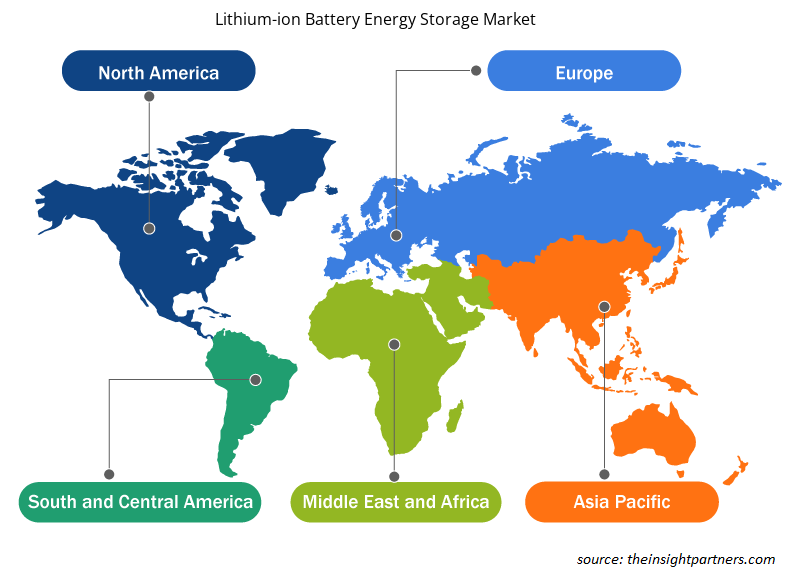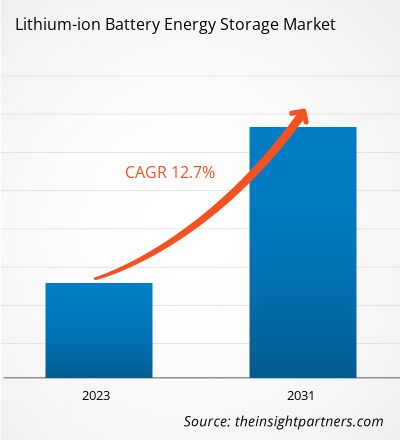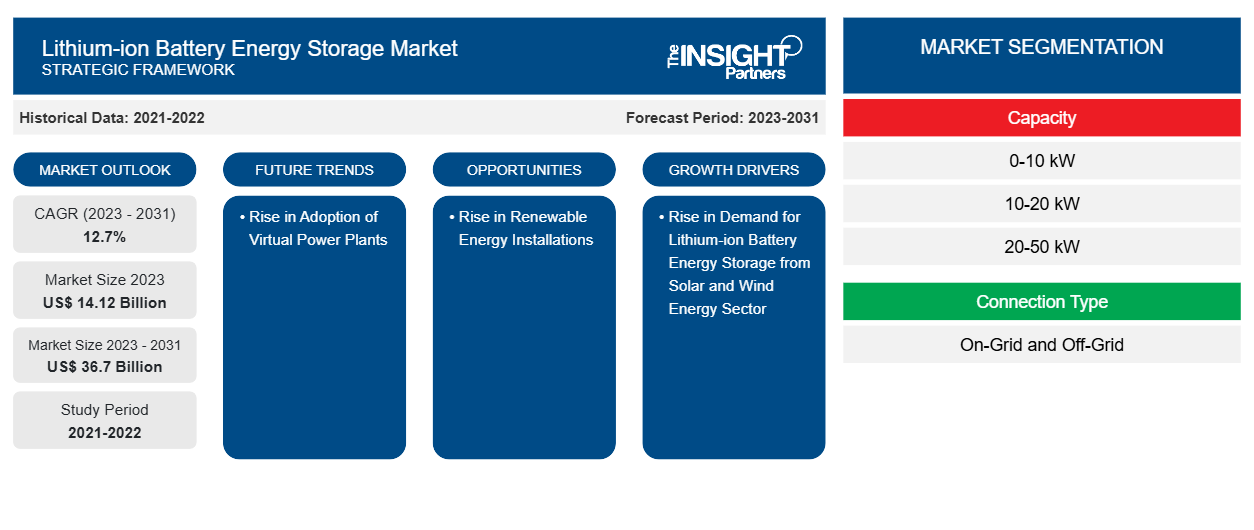리튬 이온 배터리 에너지 저장 시장 규모는 2023년 141억 2,000만 달러에서 2031년 367억 달러로 성장할 것으로 예상됩니다. 이 시장은 2023~2031년 동안 12.7%의 CAGR을 기록할 것으로 예상됩니다. 가상 발전소에 대한 수요 증가는 리튬 이온 배터리 에너지 저장 시장의 주요 추세로 남을 것으로 예상됩니다.
리튬이온 배터리 에너지 저장 시장 분석
전 세계적으로 재생 에너지 발전에 대한 수요가 증가함에 따라 예측 기간 동안 시장 성장이 촉진될 것으로 예상됩니다. 또한 아시아 태평양, 유럽, 북미를 포함한 지역에서 태양광 및 풍력 발전소가 늘어나면서 리튬 이온 배터리 에너지 저장에 대한 수요가 촉진될 것으로 예상되며, 이는 2023년에서 2031년까지 시장 성장을 견인할 것으로 예상됩니다. 또한 운송 산업에서 탄소 배출을 줄이기 위한 전 세계 전기 자동차(EV) 산업의 성장은 재생 에너지 발전 및 배터리 에너지 저장 솔루션에 대한 수요를 촉진할 것으로 예상되며, 이는 분석된 기간 동안 시장 성장을 촉진할 것입니다.
리튬이온 배터리 에너지 저장 시장 개요
리튬 이온 배터리 에너지 저장 시장의 주요 이해 관계자는 원자재 공급업체, 구성 요소 제조업체, 리튬 이온 배터리 에너지 저장 제조업체 및 최종 사용자입니다. 원자재 공급업체는 리튬 이온 배터리 에너지 저장 시장 생태계에서 중요한 이해 관계자입니다. 호주만 전 세계 리튬의 52%를 생산합니다. 전극 재료를 기준으로 LFP, NMC, LCO, NCA, LTO 및 LMO의 6가지 유형의 리튬 셀이 있습니다. 리튬 이온 배터리에 사용되는 가장 두드러진 원자재는 양극 재료, 양극 재료, 전해질, 분리막 및 전류 수집기입니다. 셀 모양을 기준으로 원통형, 파우치형 및 프리즘형의 세 가지 유형의 리튬 이온 배터리가 있으며 각각 배터리 성능 매개변수가 다릅니다. 리튬 이온 배터리 에너지 저장 시스템에 필요한 원자재에는 리튬, 코발트, 니켈, 망간, 흑연, 구리 및 알루미늄과 같은 비철 금속 및 미네랄이 포함됩니다. 주요 리튬 이온 배터리 제조업체로는 A123 Systems LLC, Panasonic Corporation, SAMSUNG SDI Co, Toshiba Corporation 등이 있습니다.
귀하의 요구 사항에 맞게 이 보고서를 사용자 정의하세요
이 보고서의 일부 또는 국가 수준 분석, Excel 데이터 팩을 포함하여 모든 보고서에 대한 사용자 정의를 무료로 받을 수 있으며 신생 기업 및 대학을 위한 훌륭한 혜택과 할인 혜택을 이용할 수 있습니다.
-
이 보고서의 주요 시장 동향을 알아보세요.이 무료 샘플에는 시장 동향부터 추정 및 예측까지 다양한 데이터 분석이 포함됩니다.
리튬 이온 배터리 에너지 저장 시장 동인 및 기회
태양광 및 풍력 에너지 프로젝트 증가로 시장 선호
전 세계적으로 재생 에너지 기반 발전을 촉진하기 위한 태양광 및 풍력 에너지 프로젝트 설립이 증가함에 따라 향후 몇 년 동안 시장 성장이 촉진될 것으로 예상됩니다. 용량 증가는 경매, 피드인 관세, 순계량 측정 및 차액 계약을 포함한 수많은 정부 이니셔티브와 지원의 결과입니다. 2021년부터 2022년까지 다양한 경제권의 정부는 태양광 PV의 성장에 영향을 미치는 상당한 정책과 목표 조정을 실시했습니다. 예를 들어, 2021년 7월 유럽 위원회는 2030년까지 연합의 재생 에너지 목표를 32%에서 40%로 늘리자고 제안했습니다. REPowerEU 계획은 목표를 더욱 높여 2022년 5월에 45%로 늘렸습니다(이를 위해서는 600GW의 태양광 PV를 포함하여 1,236GW의 설치된 재생 에너지가 필요함). 미국 연방 정부는 2022년 8월에 세액 공제 및 기타 조치를 통해 향후 10년 동안 재생 에너지에 대한 지원을 늘리는 법률인 인플레이션 감소법을 도입했습니다. 태양광 및 풍력 발전 프로젝트를 구축하려는 정부의 이러한 이니셔티브는 향후 몇 년 동안 시장 성장을 촉진할 것으로 예상됩니다.
미래의 재생 에너지 프로젝트
재생 에너지를 통합한 배터리 저장 시스템(BESS)은 에너지 자립, 비용 효율성, 에너지 회복력, 환경적 이점 및 그리드 지원과 같은 엄청난 이점을 제공합니다. 이것이 많은 선진국이 재생 에너지에 의존하는 이유입니다. 국제 에너지 기구(IEA)에 따르면 중국은 2022년에서 2027년 사이에 전 세계 신규 재생 에너지 용량의 약 절반을 추가할 것으로 예상되며, BESS 성장은 태양광 및 풍력 에너지에 대한 보조금이 제거되었음에도 불구하고 향후 5년 동안 가속화될 것으로 예상됩니다. BESS는 무효 전력을 전기 그리드에 주입하여 안정적인 전압 범위를 유지할 수 있습니다. 이 시스템은 간헐적 특성으로 인해 전압 변동이 발생할 수 있으므로 재생 에너지 원에 중요합니다. 완전한 정전 후 전력 시스템을 재시작할 수 있는 블랙 스타트 기능을 제공할 수 있습니다.
리튬이온 배터리 에너지 저장 시장 보고서 세분화 분석
리튬 이온 배터리 에너지 저장 시장 분석 도출에 기여한 주요 세그먼트는 용량, 연결 유형 및 최종 사용자입니다.
- 용량 기준으로 리튬이온 배터리 에너지 저장(LiBES) 시장은 0~10kW, 10~20kW, 20~50kW, 50kW 이상으로 구분됩니다. 10~20kW 세그먼트는 2023년에 더 큰 시장 점유율을 차지했습니다.
- 연결 유형별로 시장은 온그리드와 오프그리드로 분류됩니다. 온그리드 세그먼트는 2023년에 시장 점유율이 더 높았습니다.
- 최종 사용 측면에서 시장은 주거, 상업, 산업 및 유틸리티로 분류됩니다. 유틸리티 부문은 2023년에 시장에서 상당한 점유율을 차지했습니다.
지역별 리튬이온 배터리 에너지 저장 시장 점유율 분석
리튬 이온 배터리 에너지 저장 시장 보고서의 지리적 범위는 주로 북미, 아시아 태평양, 유럽, 중동 및 아프리카, 남미 및 중부 아메리카의 5개 지역으로 나뉩니다.
아시아 태평양 지역은 2023년에 43% 이상의 점유율로 시장을 선도하고 있습니다. 중국은 아시아 태평양 지역의 리튬 이온 배터리 에너지 저장 시장에서 두드러진 국가 중 하나입니다. 중국 국가 에너지 관리국(NEA)에 따르면 태양광 및 풍력 에너지 생산은 21% 증가하여 2022년에 1,190TWh에 도달했습니다. 이는 중국의 총 전기 소비량의 13.8%를 차지하며, 모든 도시 및 농촌 가구의 소비량과 거의 같습니다. 또한, 지원적인 정부 정책은 재생 에너지 용량 설치를 더욱 확대할 것입니다. 중화인민공화국(PRC) 국무원에 따르면, 중국은 2022년에 총 125GW의 태양광 및 풍력 발전소를 추가하여 총 용량을 1,213GW로 늘렸으며, 그 중 태양광이 87.4GW를 차지했습니다. 태양광 및 풍력 에너지 프로젝트를 개발하려는 이러한 이니셔티브는 2023년부터 2031년까지 리튬 이온 배터리 에너지 저장 시장을 활성화할 것으로 예상됩니다.
리튬 이온 배터리 에너지 저장 시장 지역 통찰력
Insight Partners의 분석가들은 예측 기간 동안 리튬 이온 배터리 에너지 저장 시장에 영향을 미치는 지역적 추세와 요인을 철저히 설명했습니다. 이 섹션에서는 북미, 유럽, 아시아 태평양, 중동 및 아프리카, 남미 및 중미의 리튬 이온 배터리 에너지 저장 시장 세그먼트와 지리에 대해서도 설명합니다.

- 리튬이온 배터리 에너지 저장 시장에 대한 지역별 데이터 얻기
리튬이온 배터리 에너지 저장 시장 보고서 범위
| 보고서 속성 | 세부 |
|---|---|
| 2023년 시장 규모 | 141억 2천만 달러 |
| 2031년까지 시장 규모 | 367억 달러 |
| 글로벌 CAGR (2023-2031) | 12.7% |
| 역사적 데이터 | 2021-2022 |
| 예측 기간 | 2023-2031 |
| 다루는 세그먼트 |
용량별
|
| 포함된 지역 및 국가 |
북아메리카
|
| 시장 선도 기업 및 주요 회사 프로필 |
|
시장 참여자 밀도: 비즈니스 역학에 미치는 영향 이해
리튬 이온 배터리 에너지 저장 시장은 소비자 선호도의 변화, 기술 발전, 제품의 이점에 대한 인식 증가와 같은 요인으로 인해 최종 사용자 수요가 증가함에 따라 빠르게 성장하고 있습니다. 수요가 증가함에 따라 기업은 제품을 확장하고, 소비자의 요구를 충족하기 위해 혁신하고, 새로운 트렌드를 활용하여 시장 성장을 더욱 촉진하고 있습니다.
시장 참여자 밀도는 특정 시장이나 산업 내에서 운영되는 회사나 기업의 분포를 말합니다. 주어진 시장 공간에 얼마나 많은 경쟁자(시장 참여자)가 존재하는지 그 규모나 전체 시장 가치에 비해 나타냅니다.
리튬 이온 배터리 에너지 저장 시장에서 운영되는 주요 회사는 다음과 같습니다.
- 넥스트에라 에너지
- 주식회사
- 코레파워
- 에넬 그린 파워
- 드래곤플라이 에너지
- 지멘스 에너지
면책 조항 : 위에 나열된 회사는 어떤 특별한 순서에 따라 순위가 매겨지지 않았습니다.

- 리튬 이온 배터리 에너지 저장 시장의 주요 기업 개요를 알아보세요
리튬이온 배터리 에너지 저장 시장 뉴스 및 최근 개발
리튬 이온 배터리 에너지 저장 시장은 1차 및 2차 연구 이후의 정성적, 정량적 데이터를 수집하여 평가합니다. 여기에는 중요한 기업 간행물, 협회 데이터 및 데이터베이스가 포함됩니다. 리튬 이온 배터리 에너지 저장 시장의 몇 가지 개발 사항은 다음과 같습니다.
- Morrow Batteries와 ABB는 파트너십을 강화하고 사회의 모든 부문에서 재생 에너지원과 전기화로의 전환을 진전시키기 위해 두 개의 양해각서에 서명했습니다. 계약에 따라 ABB는 Morrow의 제조 및 전력 공급을 위한 비독점적 우선 기술 공급업체로 선정되었습니다. 목표는 노르웨이의 Eyde Energy Park에 계획된 기가 팩토리가 전 세계적으로 가장 비용 효율적이고 지속 가능한 시설 중 하나가 되도록 하는 것입니다. 이 파트너십은 ABB의 전문성과 경험을 활용하여 Morrow의 제조 공정을 최적화하고 고품질의 지속 가능한 배터리 생산을 가능하게 하는 것을 목표로 합니다. (출처: ABB Ltd, 보도자료, 2022년 9월)
- Exide Industries와 합작 투자 파트너인 Leclanche SA가 구자라트에 인도 최대의 리튬 이온 배터리 공장을 설립한다고 발표했습니다. 이 공장은 자동화된 조립 라인 6개와 설비 용량 1.5GWh를 보유하고 있습니다. 자동차 및 에너지 저장 애플리케이션용 배터리 생산에 집중할 예정입니다. 합작 투자 회사인 Nexcharge는 이 시설에서 대량 생산을 시작한다는 성명을 발표했습니다. (출처: Exide Industries Ltd, 보도자료, 2022년 5월)
리튬 이온 배터리 에너지 저장 시장 보고서 범위 및 제공물
"리튬 이온 배터리 에너지 저장 시장 규모 및 예측(2021-2031)" 보고서는 아래 영역을 포괄하는 시장에 대한 자세한 분석을 제공합니다.
- 범위에 포함된 모든 주요 시장 세그먼트에 대한 글로벌, 지역 및 국가 수준의 리튬 이온 배터리 에너지 저장 시장 규모 및 예측
- 리튬 이온 배터리 에너지 저장 시장 동향 및 동인, 제약 및 주요 기회와 같은 시장 역학
- 자세한 PEST 및 SWOT 분석
- 주요 시장 동향, 글로벌 및 지역 프레임워크, 주요 업체, 규정 및 최근 시장 개발 사항을 포괄하는 리튬 이온 배터리 에너지 저장 시장 분석
- 시장 집중도, 히트맵 분석, 유명 업체 및 리튬 이온 배터리 에너지 저장 시장의 최근 개발 사항을 다루는 산업 환경 및 경쟁 분석
- 자세한 회사 프로필
- 과거 분석(2년), 기준 연도, CAGR을 포함한 예측(7년)
- PEST 및 SWOT 분석
- 시장 규모 가치/거래량 - 글로벌, 지역, 국가
- 산업 및 경쟁 환경
- Excel 데이터세트
최근 보고서
관련 보고서
사용 후기
구매 이유
- 정보에 기반한 의사 결정
- 시장 역학 이해
- 경쟁 분석
- 고객 인사이트
- 시장 예측
- 위험 완화
- 전략 기획
- 투자 타당성 분석
- 신흥 시장 파악
- 마케팅 전략 강화
- 운영 효율성 향상
- 규제 동향에 발맞춰 대응























 무료 샘플 받기 - 리튬 이온 배터리 에너지 저장 시장
무료 샘플 받기 - 리튬 이온 배터리 에너지 저장 시장